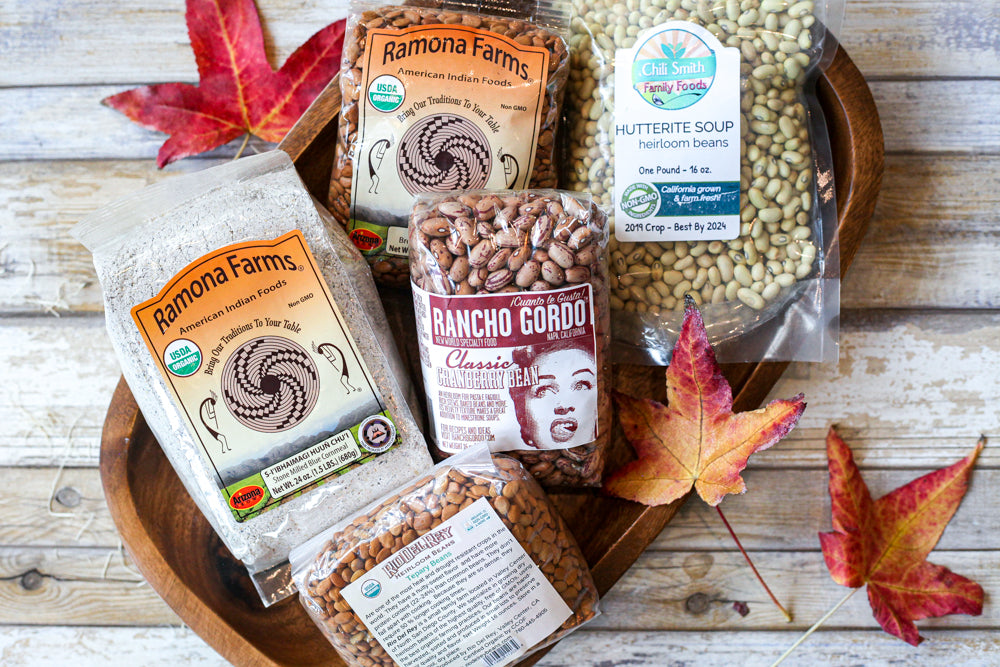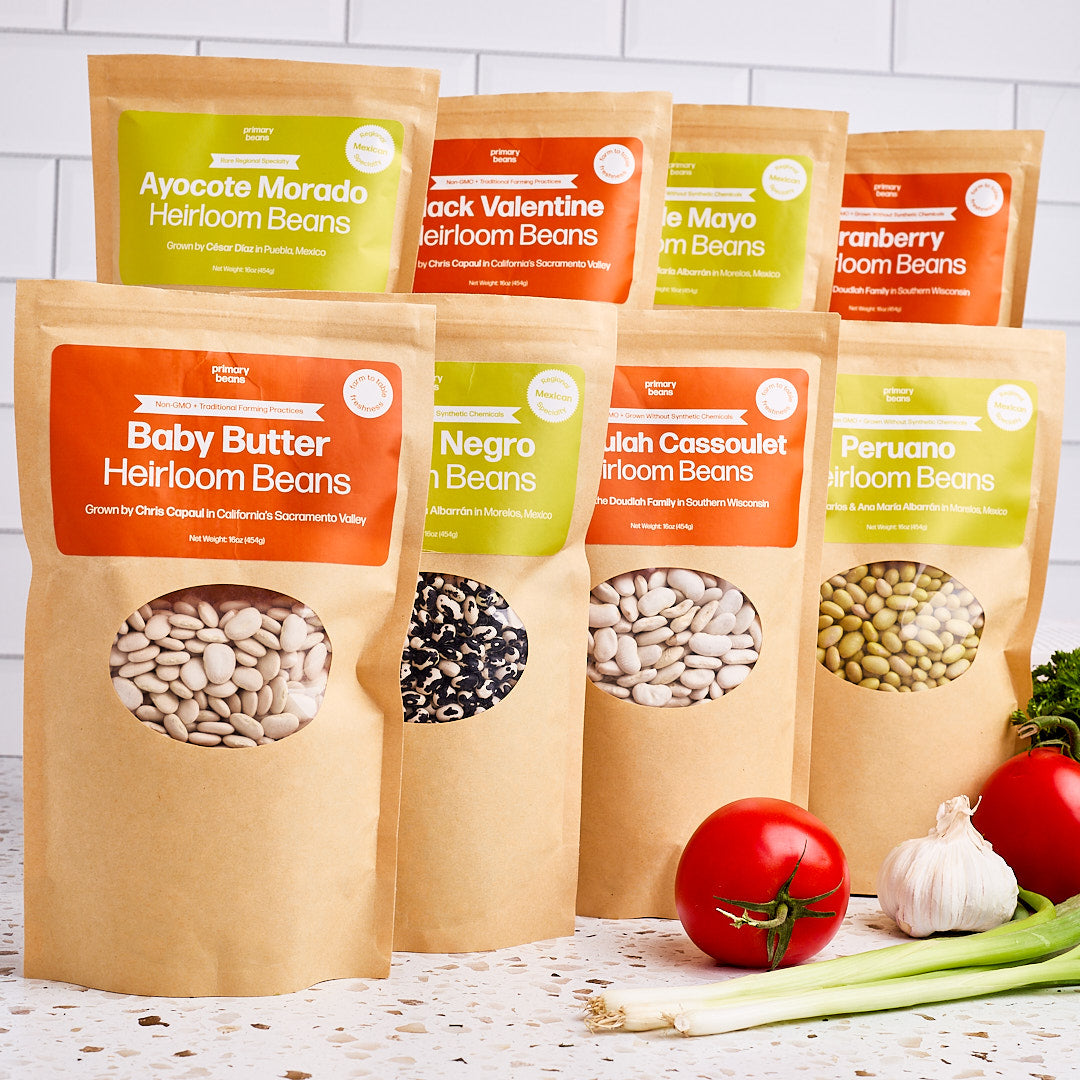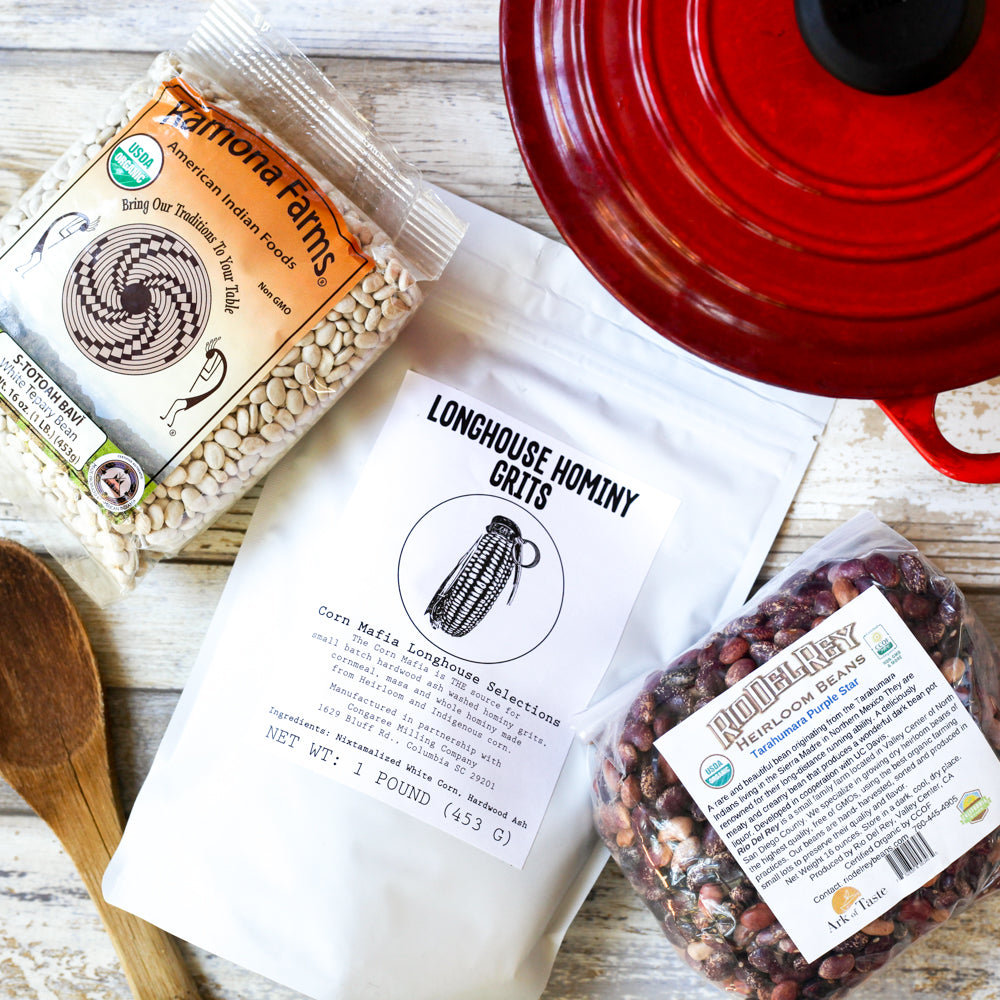10.99 FLAT RATE SHIPPING
10.99 FLAT RATE SHIPPING
SHOP

November Heirloom Bean and Grain Club
November 02, 2021 6 min read
November is National Native American Heritage Month and we are excited to be showcasing indigenous ingredients. From the ancestral lands of the Pima people to your table we are hoping that their stories will bring new traditions to your family. Perhaps you will recount the story of the Three Sisters as you serve them as soup or a three sisters mash next to your turkey this year.
The Family Box Contains:
Organic brown tepary beans, cranberry beans, organic gold tepary beans, hutterite beans, organic Hopi blue cornmeal
Regular Size Contains:
Organic brown tepary beans, cranberry beans, organic Hopi blue cornmeal
Bean Only Contains:
Organic brown tepary beans, cranberry beans, hutterite beans
ORGANIC TEPARY BEANS
The tepary bean has been handed down for countless generations amongst the Akimel O’Odham (River People, Pima) people and the Tohono O’Odham (Desert People). It is native to the Sonoran Desert and has been cultivated by the indigenous people of the region for 4,000 years.The bavi or tepary bean, is the most drought adapted species of bean in the world.
Tepary beans are culturally very important to indigenous people of Southern and Central Arizona. It is said that the Tohono O’Odham, once referred to as Papago, were named after Papavi Kuadam which means ‘tepary eaters’. The tepary bean was once a large part of the indigenous diet in the Sonoran Desert, farmed in abundance along the Gila river. The reservation system caused a loss of traditional farming traditions and in the later 1800s the river was dammed and diverted with devastating effects. By the 1950s the tepary had all but disappeared. Due to the efforts of Ramona Farms the Akimel O'Odham people once again grow the tepary bean on their tribal land.
There are many colors of Tepary Bean however the brown is the most traditional. The family box contains both brown and the more rare gold tepary beans. The brown is grown on the O'Odham tribal land by Ramona Farms, the gold is grown in San Diego County by Rio Del Rey Farms. Both are grown organically using traditional farm methods. We encourage you to cook a small portion of each with just salted water to compare.
The Three Sisters
The three sisters play a very important roll in Native American culture and foodways. Corn, beans and squash have been planted together and cooked together since ancient times. The beans are planted at the base of the corn, providing a natural trellis, the squash is planted around the corn and beans and the spiny leaves provide protection against predators. The beans in turn give nitrogen back to the soil for her sisters.
After being forced from their homes and relocated to the reservation system in the 1800s, many of these customs were lost. As they began the hard journey, the Native Americans sewed seeds into their clothes and hid them in their belongings, but reservations most often lacked water and resources for farming. Over time the knowledge of these traditions and many others were lost. The diet of the native people suffered as they lost this connection, causing an epidemic of obesity and diabetes. Thankfully many Native people are rediscovering their traditional foodways. There is a cultural resurgence that provides hope for us all. By learning from this ancient wisdom regenerative farming is creating more nutrient dense food that is also giving back to the earth.
Almost every Native American Nation seems to have its own myths and legends surrounding the three sisters. In each story they are central to our spiritual connection to the earth. My favorite is the legend of the 3 sisters who lived in a field together and loved each other. The eldest was tall and thin with golden hair and a green shawl, the middle sister wandered around the fields, the youngest could only crawl and needed to hold onto someone to stand up. One day in late summer a boy came to the field and they were fascinated with him, that night the youngest disappeared. A few weeks later he returned and this time the middle sister disappeared. The oldest sister was very sad and missed her sisters very much. At harvest time the boy returned and heard her crying so he took her to his home where she was united with her sisters. The sisters had decided to stay with the boy and his family because it was warm in their hut and they had a big pot of soup they were making. The sisters loved the family and dried themselves on a shelf so that they could help feed the family. From that day on, the family was never hungry and the sisters were never separated.
Three Sisters Soup
- 2 tablespoons olive oil
- 1 cup of chopped onion
- 1 cup of brown or gold tepary beans
- 5 cups of veggie, chicken or turkey stock (if making this after Thanksgiving it is a wonderful way to use home made turkey stock)
- 2 cups of fresh or frozen corn
- 1/2 cup of mesquite dried pima corn soaked overnight (optional)
- 1 bunch of fresh sage leaves
- 1 teaspoon dried oregano
- 1/2 teaspoon dried cumin
- 1-2 dried peppers
- 2 cups of diced squash (We used a combination of yellow and green but acorn squash is lovely in this as well)
- 1 teaspoon finely chopped fresh sage
- Salt and Pepper
- (optional) chunks of left over turkey meat
Coat the bottom of a large pot or your instant pot with olive oil and saute the onion until soft but not brown. Add the beans, dried corn, stock, herbs and dried peppers. Bring to a boil and then reduce to a simmer, cover and cook for 1 hour. Add the fresh corn, squash and chopped fresh sage and simmer for another hour until the beans are fully cooked and the flavors have melded. (You could also add everything to a pressure cooker and cook for 45 minutes or in a slow cooker 4-6 hours). remove the sage leaves and dried pepper, season with salt and pepper and serve.
CRANBERRY BEANS
These cranberry beans is thought to have originated in South America and made their way north and eventually to Europe where the Italians fell in love with them. They are a delectably creamy, versatile bean with festive red and white coloring. Food historians are uncertain about how they got the name cranberry bean but it has stuck.
There is, however another very rare cranberry bean called the True Red Cranberry Bean with Native American origins and recognized in the Slow Food Ark of Taste. It was grown extensively in Northern America by the Abenaki tribe of northern New England/Quebec. The true red is much smaller and is completely dark red, almost maroon, resembling a small cranberry. During spring lumber drives, they cooked and served huge quantities of the beans to Maine woodsmen via cooking shacks set on rafts that floated down Maine rivers. We hope to be able to offer this very special bean to you eventually, it is not commercially grown anywhere and is only saved due to the efforts of a few determined farmers and seed savers.

How To Use Them
Cranberry beans are a traditional component in Pasta e Fagioli and we love this version by Saveur Magazine. Chili fall nights and pumpkins have us turning to this delicious Cranberry Bean and Pumpkin Stew by Food and Wine. They would also be an excellent choice for our heirloom bean and parmesan soup.
ORGANIC HOPI BLUE CORNMEAL
This very rare ingredient is sustainable grown from heirloom seeds passed down from generation to generation in the Hopi tribe and grown by Ramona Farms. It is stone ground to create a coarse cornmeal that is grey/blue in color and has a more nutty taste than yellow cornmeal.

How To Use It
The distinctive flavor of the Hopi Blue Cornmeal is unlike any cornmeal you've ever had before. It has a decidedly southwestern taste that makes amazing tamales and blue corn cakes. We're going to use it to make cornbread for a southwestern cornbread stuffing this year. This cornbread recipe excellent as a side with a steaming bowl of chili or bean soup.
HUTTERITE BEANS
Once believed to have been brought over from Ukraine by the Hutterites, a Christian sect, in the mid-1800s, this bean is now thought by some to be a selection from the China Yellow bean, widely grown since the early 1800s. Regardless of its origin they are a delicious creamy white bean. They have tender skins but hold up well to long cooking, making them ideal for soups. A little tip, cook the entire pound, dry them off and freeze them in an air tight container, and you can add them to soups and salads for a last minute dinner with high protein and fiber. We're loving them in this delicious white bean soup recipe from Food and Wine.
Recent Articles
About Us
Foodocracy is dedicated to creating a more sustainable and independent food system. We support small, independent farms across the nation.
Get impossible to find beans and grains shipped direct to your doorstep each month from small family farms.
We support small, family owned farms across the nation. Did you know that farmers only make an average of 10 cents on every dollar you spend at the supermarket? Working directly with farms and not middle men ensures that more money goes back to the people actually growning your food.
Get 10% Off
Sign up for delicious recipes and special offers.
**Regularly priced items only.



